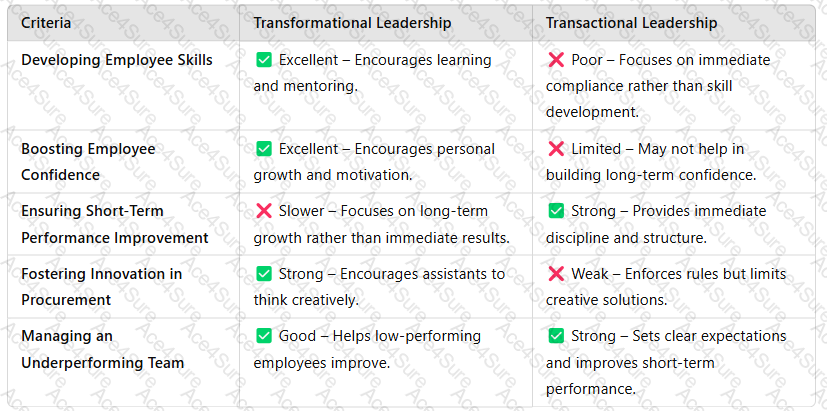Introduction
Leadership is a critical factor in shaping employee performance, motivation, and overall organizational success. In procurement, managers must adopt a leadership style that aligns withtheir team's capabilities, business objectives, and operational challenges. Two widely recognized leadership styles areTransformational LeadershipandTransactional Leadership, each with distinct characteristics and effects on team performance.
This essay will discussboth leadership styles, outlining their advantages and disadvantages. It will then evaluatewhich approach is best suited for Mo, a procurement manager facingskill and confidence issues among his team members.
Understanding Transformational Leadership
Definition
Transformational leadershipis a leadership style that focuses oninspiring, motivating, and developing employeesto reach their full potential. Transformational leaders act asmentors and role models, encouraging innovation, professional growth, and long-term performance improvements.
Key Characteristics of Transformational Leadership
Inspiration and Motivation– The leader encourages employees to perform beyond expectations through a compelling vision.
Individualized Support– Focuses on mentoring and coaching employees to enhance their skills.
Encourages Innovation– Employees are empowered to think creatively and solve problems.
Develops Future Leaders– Focuses on long-term talent development rather than short-term task completion.
High Engagement and Emotional Intelligence– Builds strong relationships with employees and fosters a positive workplace culture.
Advantages of Transformational Leadership
✅Encourages professional growth– Employees develop new skills and gain confidence.✅Increases motivation and job satisfaction– Employees feelvalued and supported.✅Promotes innovation and continuous improvement– Encourages employees tothink creatively.✅Builds long-term organizational success– Createsfuture leadersthrough mentoring and skill development.
Disadvantages of Transformational Leadership
❌Time-consuming– Requiressignificant time and effortfor mentoring and development.❌Not suitable for urgent performance issues– If immediate performance improvement is needed, transformational leadership may betoo slow.❌Employees may resist change– Some employees may beunwilling to embrace coaching and new expectations.
Understanding Transactional Leadership
Definition
Transactional leadershipis a leadership style based on astructured, performance-driven approach. It focuses onclear expectations, rewards for success, and consequences for underperformance. This style is best suited for improvingtask efficiency, enforcing compliance, and ensuring consistency.
Key Characteristics of Transactional Leadership
Clear Expectations and Rules– Employees have defined roles and responsibilities.
Performance-Based Rewards and Punishments– Good performance is rewarded, while poor performance is corrected through disciplinary actions.
Focus on Efficiency and Results– Emphasizes productivity and operational efficiency over employee growth.
Short-Term Performance Goals– Ensures immediate improvements in employeeperformance.
Hierarchy and Structure– Follows a strict chain of command.
Advantages of Transactional Leadership
✅Ensures short-term efficiency and compliance– Clearly defines expectations, which leads toimmediate improvementsin performance.✅Effective for structured tasks– Employees know exactly what is expected, reducing uncertainty.✅Increases accountability– Employees areheld responsible for meeting targets.✅Useful for crisis management– Provides aclear directivein high-pressure situations.
Disadvantages of Transactional Leadership
❌Limited employee development– Focuses more ontask completionrather than skill enhancement.❌Can reduce creativity and innovation– Employees may feel restricted by rigid expectations.❌May reduce motivation– Over-reliance on rules and punishments can createa negative work environment.❌Not ideal for building long-term talent– Employees may notdevelop leadership skills or confidence.
Which Leadership Style is Most Suitable for Mo?
Case Study Analysis: Mo’s Leadership Challenge
Mo is aprocurement managerleading a team of5 procurement assistants.
Theassistants are underperformingdue tolack of skills and confidence.
Mo isconcerned about their abilityto complete procurement tenders accurately.
Evaluating the Best Leadership Approach for Mo
 A screenshot of a computer
AI-generated content may be incorrect.
A screenshot of a computer
AI-generated content may be incorrect.
Based on thespecific challengesMo is facing,neither leadership style alone is perfect. Instead, acombined approachismost suitable:
Recommended Approach: A Blend of Transformational and Transactional Leadership
Short-Term Approach: Transactional Leadership for Immediate Performance Improvement
Mo shouldset clear expectations and enforce accountabilityto ensure the assistantsimprove their performance in procurement tenders.
Implement astructured training programwith performance benchmarks.
Useperformance-based incentives(e.g., bonuses, recognition for accurate work).
Provideconstructive feedbackon mistakes to encourage learning.
Long-Term Approach: Transformational Leadership for Skill Development and Confidence
Mo should act as amentor and coach, providingcontinuous learning opportunities.
Encourage assistants todevelop confidencein procurement byassigning them progressively challenging tasks.
Inspire the team byhighlighting the importance of procurement excellencein achieving organizational goals.
Implementpeer learning and mentorship programsto create a supportive learning environment.
Conclusion
BothTransformational LeadershipandTransactional Leadershipoffervaluable benefits, but in the case of Mo’sunderperforming team, ablended approach is the most effective strategy.
Transactional Leadership should be used in the short termtoimprove immediate performance, enforce accountability, and ensure accuracy in procurement tenders.
Transformational Leadership should be introduced graduallytodevelop skills, boost confidence, and foster long-term career growthamong the procurement assistants.
Bycombining both approaches, Mo canquickly improve his team’s performance while ensuring they gain the necessary skills and confidence to succeed in procurement. Thisbalanced leadership approachensuresshort-term efficiency and long-term growth, making it the most effective strategy for Mo's situation.

 A screenshot of a computer
AI-generated content may be incorrect.
A screenshot of a computer
AI-generated content may be incorrect.
